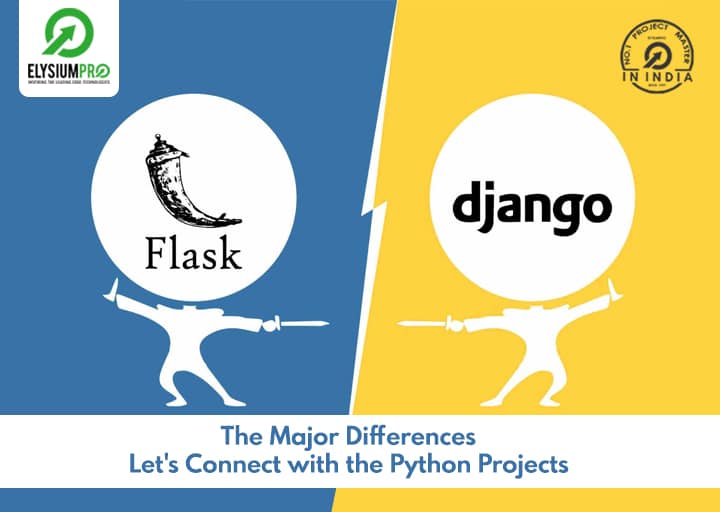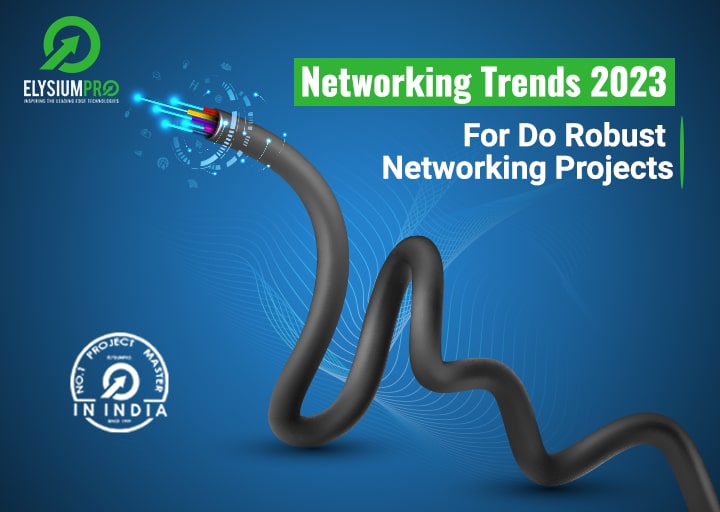
Flask vs Django The Major Differences – Let’s Connect with the Python Projects
May 20, 2023
Networking Trends 2023: For Do Robust Networking Projects
May 26, 2023Top 10 Networking Trends A computer network is a bunch of computers interconnected to pass information from one device to another. It is mainly based on common communication between networks. In other words, it’s a collection of different devices that can transmit with each other and exchange data. “This blog is particularly interesting to undergraduates and graduate students who wish to select a topic for an innovative computer networking project. The great starting point for computer networking projects.”
A network is a collection of multiple devices connected by communication links. This connection is made in three ways:
Data transfer over wireless radio waves/electromagnetic waves, direct physical cables/wires, and physical media.
In upcoming topics, Next, you need to know the Networking Trends. Top 10 Networking Trends
- Artificial Intelligence (AI) and Machine Learning (ML)
- DevOps
- Digital transformation
- Intent-based networking (IBN)
- Augmented reality and virtual reality
- 5G and Wi-Fi 6 technology
- Cloud computing
- Internet of Things (IoT)
- Data Security
- SD-WAN

Table of Contents
1. Artificial Intelligence (AI) and Machine Learning (ML)
In Top 10 Networking Trends, Using AI and ML capabilities to address complex network and business problems in real time, AI can take intelligent actions based on those predictions. Advanced analytics in automated systems introduces autonomous networks.
Machine learning is essential because it has experienced exponential growth and there’s a demand for engineers to help companies throughout various Top 10 Networking Trends industries identify openings for implementing the technology and the most effective, profitable ways to use it. It’s getting so important that numerous companies seek to fill the range of IT positions with individuals who bring a background or experience with machine learning.
2. DevOps
DevOps is closely related to software development Top 10 Networking Trends and IT. DevOps improves the relationship between network service designers and engineers to make operational changes to services.
Learning DevOps course is an essential skill to learn to make your software development lifecycle more efficient. First, create a good DevOps project with which any DevOps engineer should be familiar, following the Fundamentals of Linux and Scripting, Configuration Management, Constant Integration, Automation, Continuous Delivery, and Infrastructure as Code.
3. Digital transformation
Each definition of digital transformation varies by industry and project. However, key factors may include:
- Rethinking business models.
- Changing the underlying technology stack.
- Innovating from a customer experience perspective.
- Even reshaping organizational culture.
Digital transformation transforms businesses in all sectors, forcing them to rethink and adapt their products, services, processes and business models and projects for that the future is worth more
4. Intent-based networking (IBN)
Intent-based networking (IBN) is a systematic Top 10 Networking Trends approach that links infrastructure management and business intent. It is a network management approach in which artificial intelligence (AI) and machine learning (ML) play a key role by automating all organizational tasks that can be applied across the network. They help achieve a particular purpose or intention.
This method bridges the gap between business and IT. Business purpose is captured and continuously aligned with the end-to-end network for application service levels, security policies, compliance, operations and business processes.
5. Augmented reality and virtual reality
Augmented Reality (AR) connects a digital element Top 10 Networking Trends to your live view, often using your smartphone’s camera. (VR) Virtual Reality is an entirely immersive experience that keeps out the physical world. And this role is a big impact on future technology. AR and VR have carried on a huge role in Health and education. It takes a major revolution in All Industries and Companies, increasing revenue and reducing the carbon footprint.
Final year students
Can get more knowledge in networking by knowing these Networking trends
6. 5G and Wi-Fi 6 technology
5G or advanced cellular technology. It features faster, lower latency, and greater flexibility for wireless service. 5G will provide seamless open roaming capabilities between cellular and Wi-Fi access.
5G final year projects are developed to help you Top 10 Networking Trends formulate the skills and knowledge you need to become an expert in 5G technology. We provide various final year projects covering 5G network architecture, 5G applications, 5G security, and 5G network optimization. Our projects are developed to give you a comprehensive knowledge of the technology, from the basics of 5G networks to the latest developments in 5G applications.
Final Year Projects on 5G Technology
- Block chain Technology in 5G Promoted IoT Environment
- 5G Network Slicing and Architecture
- Access Autopilot System.
- Cloud-based 5G Multi-Access Edge Computing (MEC)
- Integration of 5G with Analytics and Artificial Intelligence
- Advanced Service based architecture in 5G Network
- Key 5G Technologies

7. Cloud computing
Let see One of the inclue Top 10 Networking Trends Cloud computing is especially used to provide access to computing resources. Cloud computing provides computer services such as servers, storage, databases and networks over the Internet. Public clouds offer efficient data access, near-limitless scalability, zero capital expenditures, and pay-as-you-go services. However, a private cloud is the best choice for managing sensitive data that needs monitored access and control in Top 10 Networking Trends.
8. Internet of Things (IoT)
IoT networks are collections of devices such as sensors, gadgets, applications and software that communicate and exchange information and data without human intervention. As a result, the Internet of Things is impacting how people live and work. This allows machines to lift heavier weights or take on tedious tasks, making life healthier, more productive and more comfortable.
9. Data Security
In Top 10 Networking Trends, Data security protects digital information throughout its lifecycle from damage, theft or unauthorized access. It covers everything from hardware, software, storage devices and user devices. Access and administration controls and organizational policies and procedures.
10. SD-WAN
SD-WAN is a software-based approach to Top 10 Networking Trends managing wide area networks (WANs). This technology reduces operating costs and improves resource utilization in multi-site deployments. Network administrators using this SD-WAN technology can use bandwidth more efficiently and improve the performance of relations-critical applications without compromising data security and privacy.
The future of SD-WAN, therefore, depends on modern security tools such as SASE, ENI, and certain deployments of machine learning (ML) and AI.
Another Top 10 Networking Trends: A Comprehensive Insight by Elysium Pro
In today’s fast-evolving digital ecosystem, staying Top 10 Networking Trends ahead of technological advancements is not just an advantage—it is a necessity. One of the most crucial pillars of digital infrastructure is networking. As the world embraces digital transformation, the demand for smarter, faster, and more secure networking solutions continues to surge. Elysium Pro, a leader in academic project development and a forerunner in cutting-edge technologies, brings you this in-depth look at the Top 10 Networking Trends that are reshaping industries and driving innovation.
Whether you are a student, IT professional, or business enthusiast, understanding these trends is essential to future-proof your knowledge and career. This blog explores these networking developments through the lens of innovation and industry relevance—an approach Elysium Pro is known for.
1. 5G Network Expansion
One of the most transformative networking trends today is the global rollout of 5G technology. With speeds up to 100x faster than 4G, 5G is revolutionizing communication, IoT applications, and real-time analytics.
Why It Matters:
- Ultra-low latency
- Enhanced mobile broadband
- Reliable communication for autonomous vehicles
Elysium Pro integrates 5G-focused research projects and hands-on experimentation into its final year networking project modules, offering students a real-world edge.
2. Edge Computing in Networking
Edge computing brings data processing closer to the devices where data is generated. This reduces latency and improves performance, especially for IoT and real-time applications.
Key Benefits:
- Faster response time
- Reduced bandwidth usage
- Enhanced data privacy
This is among the most relevant networking trends for industries relying on instant data exchange. Elysium Pro provides project frameworks for edge networking simulations and use cases, making it accessible for academic learning.
3. Wi-Fi 6 and Wi-Fi 7 Adoption
Wi-Fi technology has advanced significantly, with Wi-Fi 6 already deployed in many environments and Wi-Fi 7 on the horizon. These standards offer improved speed, capacity, and performance in dense environments.
Highlights:
- Higher data transfer speeds
- Better performance in crowded areas
- Lower latency
Elysium Pro encourages project innovations based on new wireless protocols, enabling students to explore this rapidly evolving trend in networking.
4. Software-Defined Networking (SDN)
SDN separates the control plane from the data plane, allowing centralized network management. It enhances network automation and flexibility.
SDN Capabilities:
- Dynamic traffic management
- Network programmability
- Improved network efficiency
As one of the most promising networking trends, SDN is a major area of focus in Elysium Pro’s advanced networking project offerings.
5. Network Function Virtualization (NFV)
NFV allows network services to run on virtual machines instead of dedicated hardware, reducing infrastructure costs and improving scalability.
Benefits:
- Reduced CAPEX and OPEX
- Quick service deployment
- Scalability and agility
Elysium Pro helps students develop NFV-based project solutions, simulating real-world virtualized networks.
6. Artificial Intelligence in Networking
AI is making networks smarter and more adaptive. From anomaly detection to traffic prediction, AI optimizes performance and enhances cybersecurity.
AI Applications:
- Network analytics and forecasting
- Self-healing networks
- Automated threat detection
Elysium Pro incorporates AI and machine learning modules into networking project development to reflect this essential networking trend.
7. Zero Trust Network Architecture (ZTNA)
In the age of cyber threats, the concept of “never trust, always verify” has become a standard. ZTNA ensures security is enforced throughout the network.
ZTNA Features:
- Continuous user verification
- Micro-segmentation
- Least-privilege access
As security becomes integral to networking, Elysium Pro prepares students with final year projects that address ZTNA implementation.
8. Internet of Things (IoT) Integration
The proliferation of IoT devices necessitates robust and scalable networking solutions. Networking in IoT involves managing device connectivity, data transmission, and edge security.
Importance:
- Efficient data handling
- Seamless device management
- Secure communication
Elysium Pro’s IoT-based networking projects empower students to understand real-time application in smart homes, healthcare, and industrial IoT.
9. Cloud-Based Networking
Cloud networking facilitates the deployment and management of networks entirely through the cloud. It is especially relevant for remote workforces and global connectivity.
Advantages:
- Centralized control
- Easy scalability
- Cost efficiency
Elysium Pro’s training solutions cover cloud networking setups and project-based learning for hybrid network environments.
10. Cybersecurity Integration in Networking
Security is no longer a separate concern; it must be embedded into every layer of networking. Encryption, firewalls, intrusion detection, and real-time monitoring are essential elements.
Key Aspects:
- End-to-end encryption
- AI-driven threat detection
- Secure access protocols
At Elysium Pro, students are trained to develop secure networking systems, implementing firewalls and detection systems as part of their academic projects.
Networking Projects for Final Year Students
Hope to understand the Top 10 Networking Trends, We have shared Final Year Projects and ideology with development technology in the network field. As all these technologies rapidly evolve toward next-generation wireless networks, there is a growing demand for these advanced technologies in the research community. Our resource team is ready to support other enabling technologies as well.

ElysiumPro Project Center, We can help you use relevant research resources about your project, such as well-known online journals. Contact us https://elysiumpro.in/ anytime for more information.
The Future of Networking: Powered by Innovation and Prepared by Elysium Pro
The Top 10 Networking Trends future of networking is not just an extension of current technologies—it’s a complete transformation driven by innovation, automation, and security. With rapid advancements unfolding across industries, the networking landscape is entering an era defined by intelligent infrastructure and next-generation connectivity. Emerging trends such as quantum networking, satellite-based internet systems, and fully automated network orchestration are no longer science fiction—they are actively being researched, tested, and prepared for real-world deployment.
These Top 10 Networking Trends technologies aim to address existing limitations in bandwidth, latency, and scalability while introducing capabilities that were once considered impossible. Quantum networking, for instance, could revolutionize cybersecurity with virtually unbreakable encryption, while satellite-based internet promises global connectivity—even in remote and underserved regions. Meanwhile, AI-driven network orchestration will lead to self-healing, self-optimizing networks capable of adapting in real-time with minimal human intervention.
Amidst this paradigm shift, Elysium Pro remains at the cutting edge—equipping future engineers with the knowledge, tools, and hands-on training needed to thrive in this complex and rapidly evolving domain. Top 10 Networking Trends by aligning academic networking projects with these transformative trends, Elysium Pro ensures that students are not just passive learners, but active contributors to the future of digital communication.
Whether it’s through Top 10 Networking Trends simulation environments, real-time project development, or expert mentorship, Elysium Pro bridges the gap between classroom concepts and future-ready innovations. Students are empowered to explore breakthrough topics and develop practical skills that align with industry 4.0, making them competitive candidates in the job market and valuable assets in the tech workforce of tomorrow.
Why Choose Elysium Pro for Networking Projects?
When it comes to Top 10 Networking Trends academic excellence in final year networking projects, Elysium Pro stands out as a trusted partner for engineering students. With a reputation built on innovation, quality, and industry relevance, Elysium Pro empowers students to transform theoretical knowledge into practical expertise. Here’s why it is the preferred destination for networking project development:
Industry-Aligned Project Ideas
Elysium Pro doesn’t Top 10 Networking Trends offer generic or outdated topics. Every project idea is aligned with current industry requirements and the top 10 networking trends, such as 5G, SDN, Edge Computing, and Cybersecurity. This ensures students work on projects that are relevant, impactful, and capable of capturing attention in both academic and professional circles.
Hands-On Lab Infrastructure
Theory alone isn’t enough. Elysium Pro offers hands-on training in a well-equipped lab environment where students can build, test, and simulate their Top 10 Networking Trends networking projects. Access to real-time tools and technologies helps learners gain practical skills, making them confident in handling real-world networking challenges.
Certified Guidance from Experts
Students at Elysium Pro Top 10 Networking Trends benefit from mentorship under certified professionals with vast experience in networking, project design, and academic mentoring. This expert guidance ensures that each phase—from project planning and execution to documentation and presentation—is done with technical precision and clarity.
Support for IEEE and Real-Time Projects
Elysium Pro offers full-fledged support for both IEEE-based networking projects and real-time application development. This includes topic selection, algorithm design, simulation (using tools like NS2, Packet Tracer, Cisco Labs, etc.), code implementation, and final delivery. Students looking to publish or present their work at conferences also receive assistance.
Exposure to Trending Technologies
Staying ahead in networking Top 10 Networking Trends means staying updated with trends. At Elysium Pro, students get exposure to technologies that are driving change across industries—such as Wi-Fi 6, IoT, AI-powered networks, Zero Trust Architecture, and NFV. This not only enhances the quality of their project work but also builds a competitive resume for future job placements or higher studies.
Frequently Asked Questions (FAQ)
1. Why is Elysium Pro the best choice for networking final year projects?
Elysium Pro combines expert mentorship, industry-standard tools, and real-time application to help students master top networking trends through their final year projects.
2. How does Elysium Pro incorporate networking trends into its curriculum?
The organization stays updated with technological advancements and incorporates trending domains like 5G, SDN, NFV, and cybersecurity into its project modules.
3. What are the benefits of studying networking trends?
Understanding networking trends equips you with the knowledge to develop future-ready solutions, boost employability, and align your skill set with market demands.
4. Can I build a project combining multiple networking trends?
Yes, Elysium Pro encourages innovative project development that integrates multiple trends such as IoT, edge computing, and AI to create impactful real-world solutions.
5. What kind of support will I receive during my networking project?
Students get full guidance—from topic selection to deployment—including documentation, simulation tools, and technical mentoring.
Conclusion
The networking domain is undergoing rapid transformation. As new technologies emerge and converge, the demand for professionals well-versed in these top 10 networking trends continues to grow. Elysium Pro, with its commitment to excellence in engineering education and project training, ensures that students are not just passive learners but active contributors to this technological revolution.
If you are looking to build a strong foundation in next-gen networking, develop impactful projects, and be industry-ready, Elysium Pro is your ultimate academic partner. Embrace the future—today—with the top 10 networking trends curated and taught by Elysium Pro.
For more information, visit https://elysiumpro.in and explore our complete range of networking project solutions.


